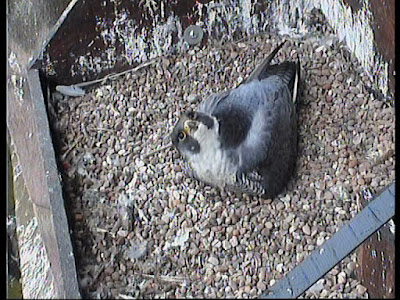 It's a deceptively quiet time now.
It's a deceptively quiet time now.We're now settling in to a routine of around 500 new visitors, plus another 500 returning visitors to our webcams every day. We welcome you all, and thank you for heeding the call to close your browsers after watching. It's done the trick, and drastically lightened the load on the Streamdays servers.
The Derby Cathedral peregrines have now settled into an incubation routine, too. It's clear that the female sits on the eggs for most of the night, getting relieved either an hour or two before dawn, or shortly afterwards. There are usually a couple of changeovers during the day before she resumes again for the night shift. Only once so far has the male spent most of the night on the eggs.
 These changeovers nornally takes less than a minute, but once or twice the eggs have been left exposed for six or seven minutes.
These changeovers nornally takes less than a minute, but once or twice the eggs have been left exposed for six or seven minutes.Sometimes the sitting bird simply doesn't want to move. More than once the larger female has seemed to stand bemused by her failure to rouse her partner, or vice versa. But she's bigger, and when she waddles slowly in from the right side of the platform he invariably gets up and flies off. If you see a changeover online you're quite lucky. Had we managed to get our audio channel up and running in time this would have been a useful early-warning of a changeover, as the birds call to each other with a gentle chirrupping or ee-chupping sound when one of them arrives on the ledge.
So how do you tell which is the male and which is the female?
The answer is it's not always easy when there's only one bird there. But look firstly for size. The female (top picture) is considerably bulkier than the male (lower picture). Because of her bulk, her wing tips usually stick upwards much more than those of the male. She is a lighter grey tone than him. If you look at the male in the lower picture, you'll see he is smaller and slightly neater in size, with a darker tone to his head and back. Note, too, the tiny white dot on his right moustache-like stripe on his head. The female doesn't have this, and it's visible too through a telescope from Cathedral Green. When they are side by side, there's no problem. She is so much bigger then he is, and he acts quite submissively to her.
We've pulled back on the zoom a little bit as the night-time focussing wasn't very sharp when the camera was really close up. At night it's nearly always the bulkier female who incubates the eggs. hatching won't be too far away, and our next blog entry will give you some clues to watch out for when it becomes imminent.
Behind the scenes it's anything but a quiet time. The DWT are busy gathering volunteers together to organise various Watch events on Cathedral Green, whilst the Museum is in talks with Streamdays about a possible full-speed streaming video service.. We've had a BBC wildlife photographer down to film at The Sanctuary and at Derby Cathedral this week for a new series on the Nature of Britain with Alan Titchmarsh. We're working on ways to remotely focus and zoom the peregrine camera in time for hatching, and we're trying to get an audio stream and a still image archive set up. That, plus the rest of our duties, it's far from a quiet time. Someone once asked whether we did this for the money. Most certainly not; it's for the love of the work that we do.
Meanwhile, enjoy watching.

2 comments:
Thank you for this site. Much better view than from the Cathedral Green. But I notice (on line) that the nest is very brightly lit at night. I assume this doesn't bother the bird, or you wouldn't do it, but it seems strange.
At night the birds are lit by a special infra-red light, which is not visible to them. The camera sees it as a bright light, but the birds themselves do not. I hope this reassures you that we're not blinding the birds with a spotlight.
Post a Comment